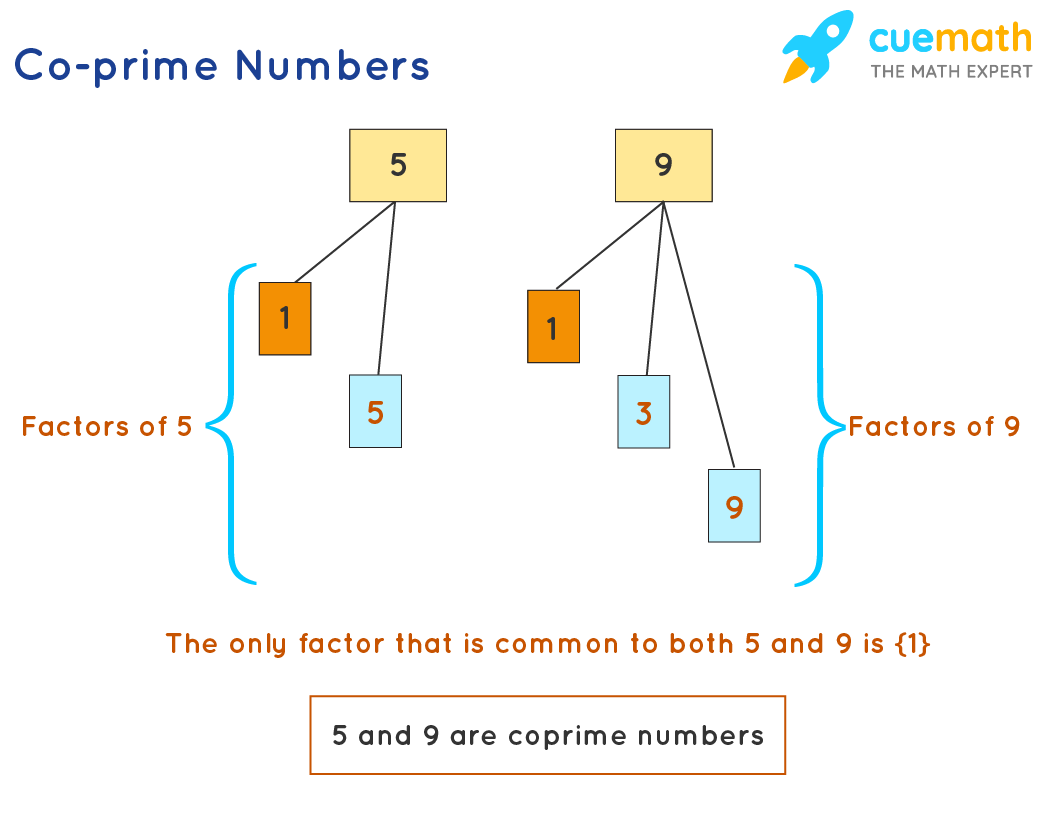Co-prime Numbers
Co-prime numbers are pairs of numbers that do not have any common factor other than 1. There should be a minimum of two numbers to form a set of co-prime numbers. Such numbers have only 1 as their highest common factor, for example, (4 and 7), (5, 7, 9) are co-prime numbers. It is to be noted that co-prime numbers need not be prime numbers always. Two composite numbers like 4 and 9 also form a pair of co-primes.
| 1. | What are Co-prime Numbers? |
| 2. | How to Find Co-prime Numbers? |
| 3. | Properties of Co-prime Numbers |
| 4. | Co-prime and Twin Prime Numbers |
| 5. | Co-prime Numbers 1 to 100 |
| 6. | FAQs on Co-prime Numbers |
What are Co-prime Numbers?
If the only common factor of two numbers a and b is 1, then a and b are co-prime numbers. In this case, (a, b) is said to be a co-prime pair. Co-prime numbers are also referred to as relatively prime numbers.
Co-prime Number Definition
The co-prime number definition tells us that if the Greatest Common Factor (GCF) of any two numbers is 1, then they are said to be co-prime.
Co-prime Number List
Given below is the list of a few co-primes for your reference.
| Pairs of Co-prime Numbers |
|---|
| (2,15) |
| (3,8) |
| (4,9) |
| (5,6) |
| (11,14) |
| (15,19) |
How to Find Co-prime Numbers?
To find whether any two numbers are co-prime, we first find their Greatest Common Factor (GCF). If their GCF is 1, we can say that they are co-prime.
Example 1: Let us consider two numbers 5 and 9. The factors of 5 are 1 and 5. The factors of 9 are 1, 3, and 9. The factor that is common to both 5 and 9 is 1. GCF of (5, 9) = 1. Thus, (5, 9) is a co-prime pair.

Example 2: Let us consider two numbers 6 and 10. The factors 6 are 1, 2, 3, and 6. The factors of 10 are 1, 2, 5, and 10. Factors that are common to both 6 and 10 are 1 and 2. So GCF (6, 10) = 2. Thus, (6, 10) is NOT a co-prime pair.

Properties of Co-prime Numbers
Co-prime numbers can be identified easily with the help of some properties that are explained below:
- The Highest Common Factor (HCF) of two coprime numbers is always 1. For example, 5 and 9 are coprime numbers, there, HCF (5, 9) = 1.
- The Least Common Multiple (LCM) of two co-primes is always their product. For example, 5 and 9 are co-prime numbers. Hence, LCM (5, 9) = 45.
- 1 forms a co-prime number pair with every number.
- Two even numbers cannot be co-prime numbers as they always have 2 as the common factor.
- The sum of two co-prime numbers is always co-prime with their product. For example, 5 and 9 are co-prime numbers. Here, 5 + 9 = 14 is co-prime with 5 × 9 = 45.
- Two prime numbers are always co-prime. They have only 1 as their common factor. Consider 29 and 31. 29 has 2 prime factors, 1 and 29 only. 31 has 2 prime factors, 1 and 31 only. 29 and 31 are prime numbers. They have only one common factor 1. Thus they are co-prime. We can check any two prime numbers and get them as co-prime. For example, 2 and 3, 5 and 7, 11 and 13, and so on.
- All pairs of two consecutive numbers are co-prime numbers. Any two consecutive numbers have 1 as their common factor.
Consider a few pairs of such numbers. Let us try with 14 and 15.
| Numbers | 14 | 15 |
|---|---|---|
| Factors | 1,2,7,14 | 1,3,5,15 |
| Common Factor | 1 |
There are multiple such combinations where 1 is the only common factor.
Co-prime and Twin Prime Numbers
Co-prime numbers are those numbers whose HCF is 1. On the other hand, twin prime numbers are those prime numbers whose difference is always 2. For example, 3 and 5 are twin prime numbers. The following points list the difference between co-prime and twin prime numbers.
- Twin prime numbers are always prime numbers while co-prime numbers can be composite numbers as well.
- The difference between two twin primes is always 2 while the difference between two co-primes can be any number.
- All the pairs of twin prime numbers are also co-prime, while all co-prime numbers may or may not be twin primes.
- 1 forms a co-prime pair with every number, while it forms twin prime pair with only 3.
Co-prime Numbers 1 to 100
In the list of co-prime numbers from 1 to 100, there are many pairs that can be listed as co-prime numbers based on the above properties. Some of the co-prime number pairs that exist from 1 to 100 are (1, 2), (3, 67), (2, 7), (99, 100), (34, 79), (54, 67), (10, 11), etc. Try out forming more such pairs of co-prime numbers by yourself. Here is Cuemath's online co-prime calculator for our ease.
Important Notes
- Two numbers are co-prime if their GCF is 1. It can also be said that if the GCF of any two numbers is 1, those are co-prime numbers.
- Co-prime numbers need not necessarily be prime numbers. For example, 12 and 35 are co-prime numbers, although, 12 and 35 are NOT prime numbers.
Tips and Tricks:
- Any two prime numbers are always co-prime.
- Any two consecutive numbers are always co-prime.
- 1 forms a co-prime pair with any other number.
- A prime number is co-prime with any other number that is not its multiple.
- Two even numbers are NEVER co-prime.
☛ Related Topics
- HCF of 2 Co-prime Numbers
- Prime Numbers up to 100
- Whole numbers
- Natural Numbers
- Rational Numbers
- Real Numbers
- Is 2 a Prime Number?
- Is 41 a Prime Number?
Cuemath is one of the world's leading math learning platforms that offers LIVE 1-to-1 online math classes for grades K-12. Our mission is to transform the way children learn math, to help them excel in school and competitive exams. Our expert tutors conduct 2 or more live classes per week, at a pace that matches the child's learning needs.
Co-prime Numbers Examples
-
Example 1: Show that 161 and 192 are co-prime numbers.
Solution:
We will find the HCF of the given numbers 161 and 192 using the division method.

The HCF of 161 and 192 is 1. Thus, they are co-prime numbers.
-
Example 2: If 59 and 97 are co-prime, what would be their HCF?
Solution:
It is given that 59 and 97 are co-prime. They cannot have any common factor other than 1. Hence, their HCF is 1.
-
Example 3: State true or false with respect to co-prime numbers.
a.) Co-prime numbers need not necessarily be prime numbers.
b.) Two even numbers are always co-prime.
Solution:
a.) True, co-prime numbers need not necessarily be prime numbers.
b.) False, two even numbers are never co-prime.

FAQs on Coprime Numbers
What are Co-prime Numbers in Math?
Coprime numbers are those numbers that do not have any common factor other than 1. Co-prime numbers form a pair of numbers that may not necessarily be prime numbers. For example, (6,35) is a set of co-prime numbers, although 6 and 35 are composite numbers.
What is the Difference Between Prime and Co-prime Numbers?
A prime number is a number that has exactly two factors, 1 and the number itself. For example, 2, 3, 7, 11 and so on are prime numbers. Co-prime numbers are pairs of numbers whose HCF (Highest Common Factor) is 1. For example, (4,9) are co-primes because their only common factor is 1.
How to Find the Co-prime of a Number?
The HCF of two co-prime numbers is 1. Thus, to find the co-prime number of a number, it is sufficient to find a number that is NOT divisible by any of the factors of the given number. For example, if we have a number 12 and we need to find a co-prime number for 12, we can list 5 as its co-prime number because 5 is not divisible by any of the factors of 12 (except 1). Therefore, (5,12) forms a pair of co-prime numbers.
Which Numbers are Identified as Co-prime Numbers?
A single number cannot be co-prime. Only a pair of two numbers whose common factor is 1 forms a pair of co-prime. In other words, two numbers are said to be co-prime if their Highest Common Factor (HCF) is 1.
Are 18 and 35 Co-prime Numbers?
Yes, 18 and 35 are co-prime numbers. The factors of 18 are 1, 2, 3, 6, 9, 18. The factors of 35 are 1, 5, 7, 35. Here, 18 and 35 have no common factor other than 1. Thus, 18 and 35 are co-prime.
Are Co-prime Numbers Always Prime Numbers?
No, co-prime numbers need not necessarily be prime numbers. For example, 18 and 25 are co-prime numbers as their HCF is 1, although 18 and 25 are NOT prime numbers.
What is the HCF of Two Co-prime Numbers?
The HCF of two co-prime numbers is always 1. As 1 is the only common factor of two co-prime numbers.
Are Two Successive Integers Always Co-prime?
Yes, two successive positive integers are always co-prime because one is an even number, the other is odd, and the HCF of two consecutive numbers is always 1.
How to Check if Two Numbers are Co-prime?
In order to check if any two numbers are co-prime or not, we need to find their Highest Common Factor (HCF). If their HCF is 1, then they are co-prime numbers.
What are the Co-prime Numbers from 1 to 100?
There are many pairs of co prime numbers from 1 to 100. A few of them can be listed as follows: (1, 2), (3, 67), (2, 7), (99, 100), (34, 79), (54, 67), (10, 11), and so on.
What is the LCM of Two Co-prime Numbers?
The LCM of two co prime numbers is their product. This is because co prime numbers do not have any common factor other than 1. For example, if we take the coprime numbers 2 and 7 and find their LCM, we will get the LCM as 14 which also their product. (2 × 7 =14)
visual curriculum